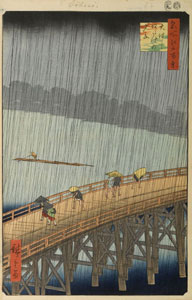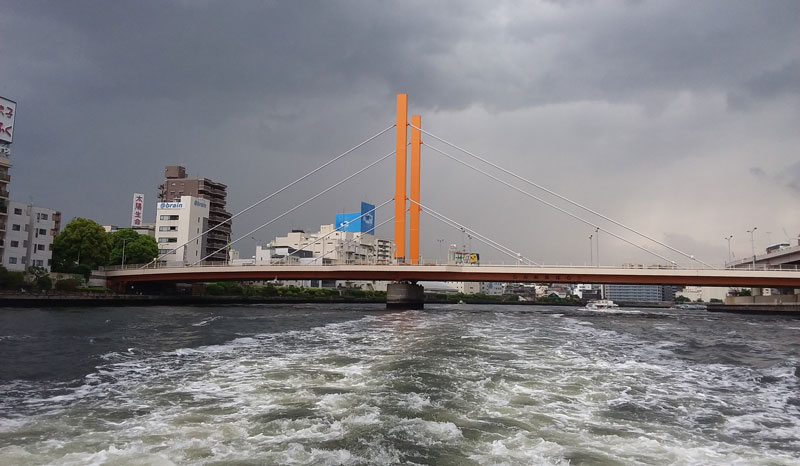
|
|

|
Hokusai - Ehon Sumida Gawa - Prints 1-9 and 1-10

|
|

|
In these two prints we see the city dwellers of Edo enjoying the cherry blossoms. However, these are completely ignored by a man dressed in black: he is on his way to celebrate Buddha’s birthday on April 8.
On the far bank on the extreme right of print 1-9 we see the quarter of Imagawachō (今川町, chō meaning quarter). The building just across the canal along Imagawachō quarter is a residence of daimyō Matsudaira from Mutsu province (松平陸奥). This province contains current day Fukushima, the prefecture that was hit by the great east Japan earthquake and its ensuing tsunami in 2011. The full name of this daimyō is Matsudaira Sadanobu (松平定信) (1759-1829). He was named the shōgun’s chief councilor in the summer of 1787 and became the regent for the 11th shōgun Tokugawa Ienari early in the next year. As the chief administrative decision-maker in the bakufu (i.e., Japanese military governement ruling Japan at that time) he launched the Kansei reforms in 1787-1793 to stabilize rice prices, cut government costs, and increase revenues. He also ordered the destruction of Nakazu (see prints 1-7 and 1-8), saying that this was needed for maritime defense and flood control, but more likely to put an end to the activities indulged in on Nakazu which - moreover - were visible day and night from his residence across the river.
The building with a basalt block basement on the far bank in print 1-10 is a residence of daimyō Matsudaira from Tōtōmi province (松平遠江), which is now known as Shizuoka prefecture.
The part of the bridge crossing the Sumida river displayed in print 1-10 is the Shin Ōhashi (新大橋, meaning new large bridge). At that time four much smaller bridges were connecting the lands on the east bank of the Sumida river between the Eitai and Shin Ōhashi bridges. Counting from down to upstream Sumida river these were the Lower bridge (下の橋 or Shimo no hashi), the Middle bridge (中の橋 or Naka no hashi), the Upper bridge (上の橋 or Kami no hashi), and the Mannen bridge (万年橋, which translates into Thousand Year bridge).
Two of these four bridges are visible on the far east bank of the Sumida river in print 1-9. These are the just mentioned Upper and Mannen bridges.
By far the most famous Japanese print displaying Shin Ōhashi bridge certainly is ‘‘Sudden shower over Shin Ōhashi bridge and Atake’’ in the ‘‘One hundred famous views of Edo’’ series designed by Utagawa Hiroshige more than fifty years later (click to enlarge):

|
Sudden shower over Shin Ōhashi bridge and Atake |
Note the barely visible boat sheds of the shōgun on the far bank of the Sumida river in this Hiroshige print. These boat sheds are plainly visible in prints 1-13 and 1-14 and prints 1-15 and 1-16 of Hokusai’s first Sumida Gawa picture book.
In his “Twelve scenes of Tokyo” series Kawase Hasui designed this print of Kami no hashi (click to enlarge):

|
The Upper bridge (Kami no hashi) from the “Twelve scenes of Tokyo” series by Kawase Hasui (1920) |
This is a picture I took of Shin Ōhashi bridge while visiting Japan in 2017:

|
Shin Ōhashi bridge today |